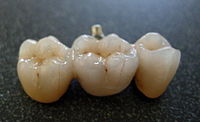
Photo from wikipedia
BACKGROUND Delayed loading in the rehabilitation of edentulous patients with an implant-supported prosthesis implies a longer treatment time. It requires additional surgery to uncover the submerged implants, and this may… Click to show full abstract
BACKGROUND Delayed loading in the rehabilitation of edentulous patients with an implant-supported prosthesis implies a longer treatment time. It requires additional surgery to uncover the submerged implants, and this may increase patients' discomfort and morbidity. OBJECTIVES The immediate loading-based technique described in this article involves creating a metal framework by intraorally welding the implants pair by pair, using specific wing abutments. The aim of the study was to investigate the implant-prosthetic success and complication rates of this technique when used to rehabilitate totally edentulous patients. MATERIAL AND METHODS The clinical records of totally edentulous patients were retrospectively evaluated. The prosthetic success rate as well as technical and biological complications were analyzed. Furthermore, the implant survival and success rates were assessed by measuring marginal bone loss (MBL) at the implant, prosthesis and patient levels. RESULTS The records of 37 patients (284 implants and 43 prostheses) were included in the study. At the last follow-up (45.5 ±33.6 months), the prosthetic success rate was 100%. Mucositis affected 4 implants (1.4%), while peri-implantitis affected 4 implants (1.4%). Meanwhile, 7 implants (2.5%) showed a lack of early osseointegration. According to the criteria of Albrektsson et al., 271 implants (95.4%) were successful. The average MBL at the implant, prosthesis and patient levels was 0.26 ±0.42 mm, 0.26 ±0.19 mm and 0.26 ±0.18 mm, respectively. CONCLUSIONS The technique described in this article seems to be a viable approach to the rehabilitation of totally edentulous patients through immediate loading. However, these results should be confirmed by appropriately designed prospective and comparative clinical studies.
Journal Title: Dental and medical problems
Year Published: 2022
Link to full text (if available)
Share on Social Media: Sign Up to like & get
recommendations!